Help a local teacher and you could win a pair of INVU sunglasses!

Amazon Wishlist: https://www.amazon.com/hz/wishlist/ls/D3RMAJNN55EV/ref=hz_ls_biz_ex?
See INVU sunglasses here!
Help a local teacher and you could win a pair of INVU sunglasses!

Amazon Wishlist: https://www.amazon.com/hz/wishlist/ls/D3RMAJNN55EV/ref=hz_ls_biz_ex?
See INVU sunglasses here!
Last month we published a popular blog post interweaving our company’s long history in downtown Bellingham with its newspaper advertisements in the 1930’s and 1940’s. Thanks again to the comprehensive resource, newspapers.com, we have more to share from the 1950’s through the 2000’s.
As Bellingham and the rest of the country moved on from the war, we observed many changes in communities. The baby boom was in full swing and more people were moving to the suburbs and out of the big cities. For this reason and the decline of many of Bellingham’s industries including fishing, lumber and canneries, the local government pushed hard for the new multilane highway (I-5) to run right through downtown and along the waterfront. The hope was to promote new factories and industry into the heart of Bellingham. As we see now, the state road planners had different ideas (Reference: Bellingham – Thumbnail History). There is no record of what the Binyon Optometrists thought of this idea, but it’s safe to say our current downtown would look much different if I-5 had been routed this way!
We find the newspaper advertisements for the 1950’s continue to highlight eye exams as scientific, glasses as precise tools. This particular advertisement catches one’s eye with the line – “Glasses become obsolete too!” Reading further, you see it’s one’s eyes that would change to cause glasses to no longer work well- cleverly emphasizing the need for yearly eye exams:
There is no question that glasses fashion took off in the 1950’s – thank you Buddy Holly. While men’s frames were mostly basic horn-rims, the ladies discovered the cat-eye. Colors became more available in women’s frames and the additions of set-in gems was common.
The following lifestyle ads connect good vision to optimal eye health- presenting a problem that can be solved with a quality eye exam and glasses:

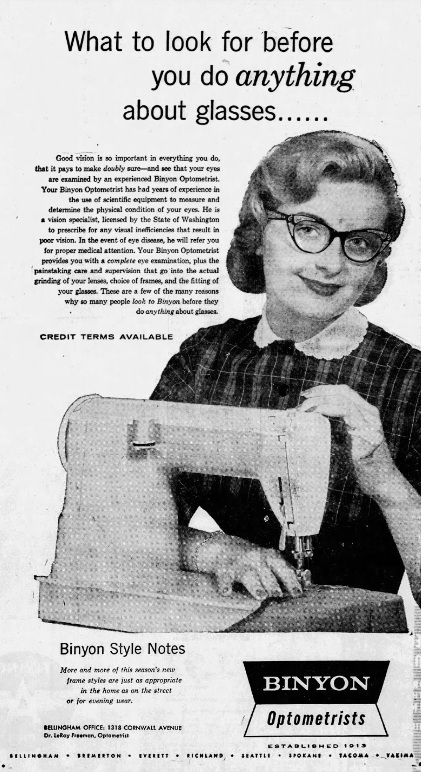

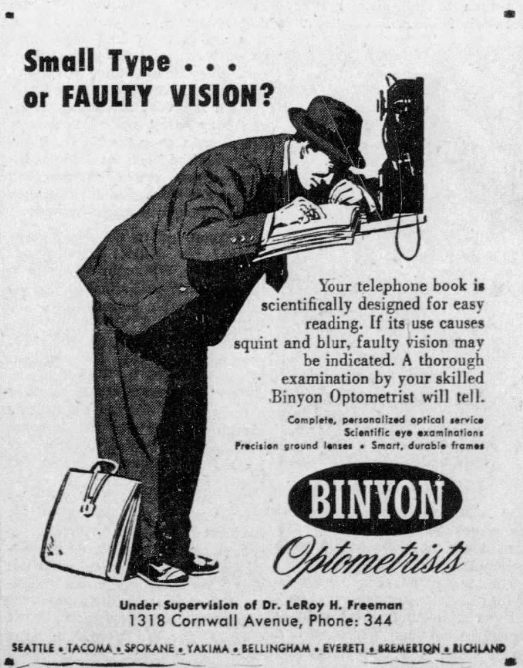
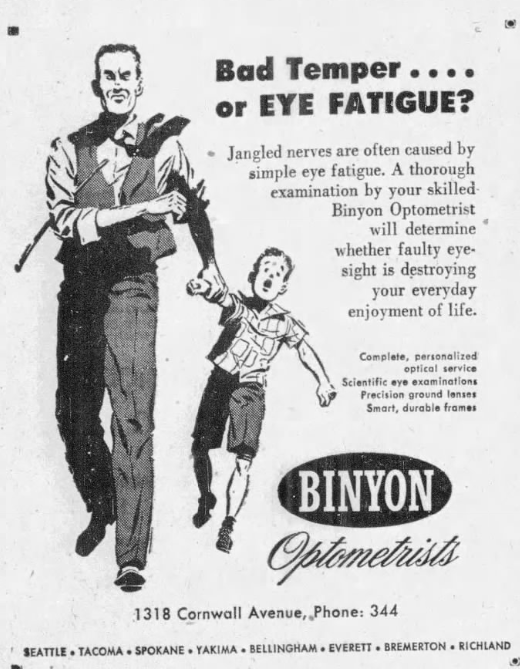
A few ads highlighted new, specialty products available from Binyon:
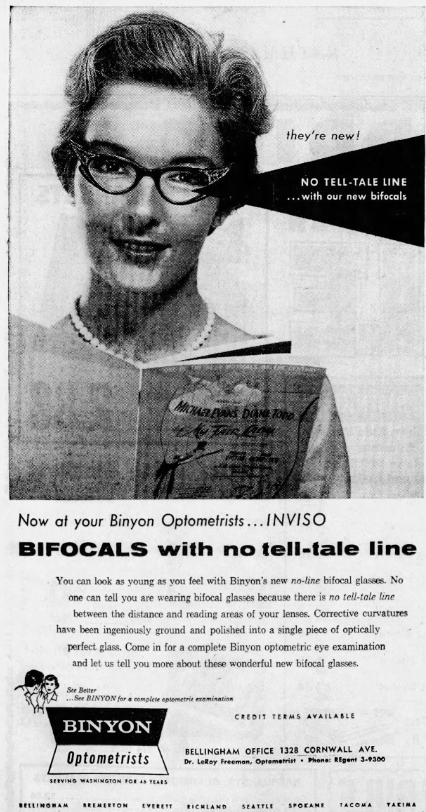
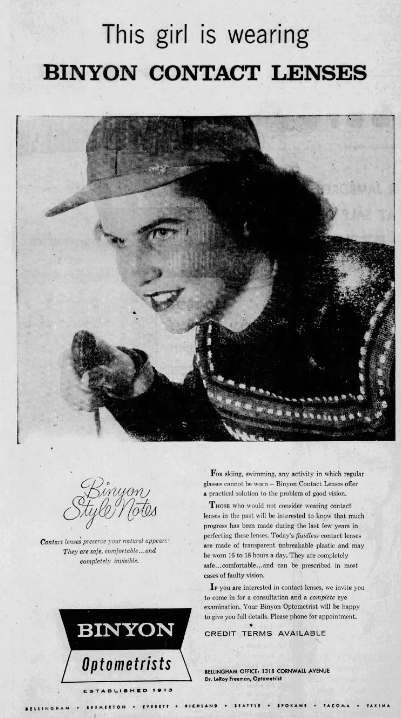
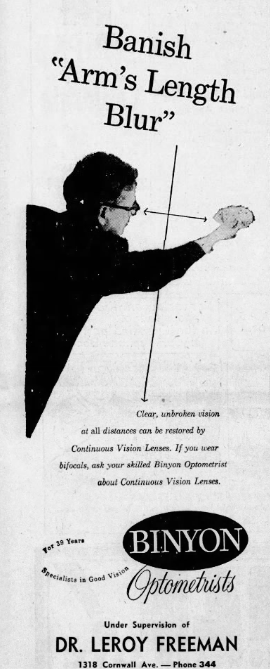
And finally, the newspaper remained the best forum to keep the public updated on store news and events:
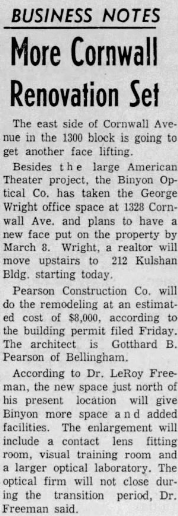
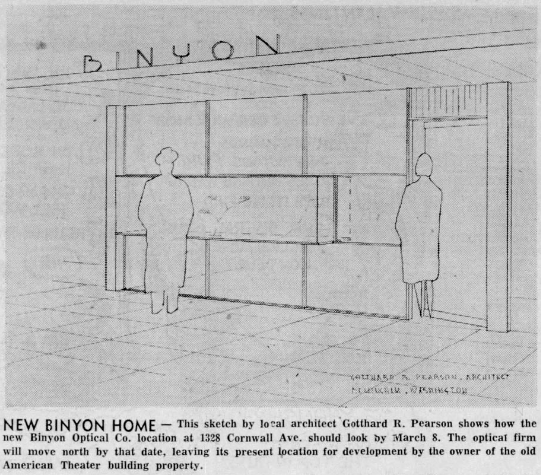

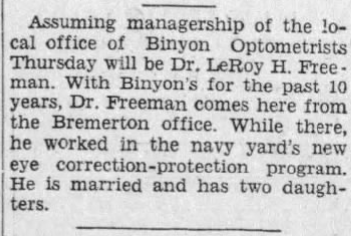

One ad that stands out to the current Binyon staff is this one that details the “Binyon Rules of Practice.” We still have this poster hanging in our office today:
This decade started with the loss of Dr. J.R. Binyon, the founder of Binyon Optometrists on June 17th, 1960. At this time, Binyon was operating twelve offices in Washington and Oregon, each with separate managers. After his passing, each office sold and the Bellingham office began running under the ownership of Dr. Leroy Freeman, Dr. Binyon’s nephew who had managed the practice since 1950. With the independent ownership, each company began marketing itself. The inclusion of other cities with Binyon offices dropped from each ad, and the number of ads dramatically reduced. In fact, we only found two from this decade. Highlighting the message that your vision affects your daily life and routine eye exams are important – the advertisement is more simple than past years. Note in this decade and the last ad of the 1950’s, the contact phone number changed from 3 digits to 5 digits.

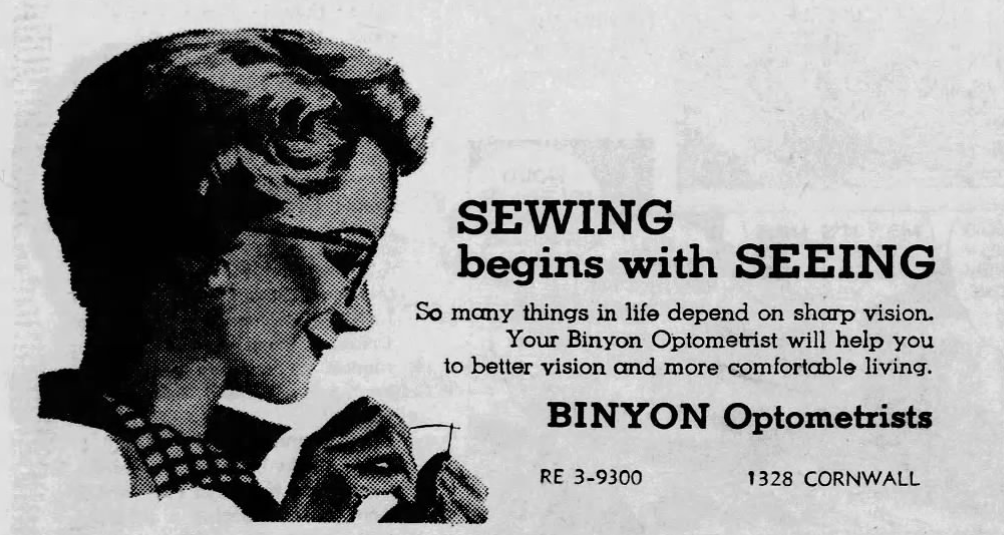
The office posted an announcement with the Bellingham Herald about a new doctor addition, a Bellingham High School graduate who also served in the Army Medical Corp, Dr. Donald Jones.
The above heading (advertisements) misleads, as we only found one Bellingham Herald advertisement run by Binyon Optometrists during the 1970’s! This ad promoted the third office move to Magnolia Street, a space Binyon occupied for about 20 years. Now the phone number is a full seven digits:
Binyon Optometrists earned a brief mention in the Local News section after a burglary:
In a Lifestyle article on glasses style, Binyon optician Rae Ann Baunach was quoted as agreeing that the “middle-age” population doesn’t like seeing themselves in bifocal glasses. The article makes the assertion that most people don’t find glasses attractive. We’re all really glad that perception has changed. Note in the photo of Marilyn Monroe the glasses were added with the question – would you ask this woman for a date? Things have definitely changed.
Activity picked up on the Binyon advertising front in the 1980’s. Dr. Mark McEathron joined the staff of doctors in 1980, announced in advertising space.

Soon after his arrival, Dr. McEathron met Curtis Dye, president of Interconnect Systems, a company specializing in business phone systems. They still both remember cleverly changing Binyon’s phone number to the current 647-2020, seen in all advertisements after 1981.
Dr. McEathron’s welcome advertisement included his specialty in child eye care. A few ads during this decade showed Binyon’s creation of a free vision screening for children, not yet required in schools.

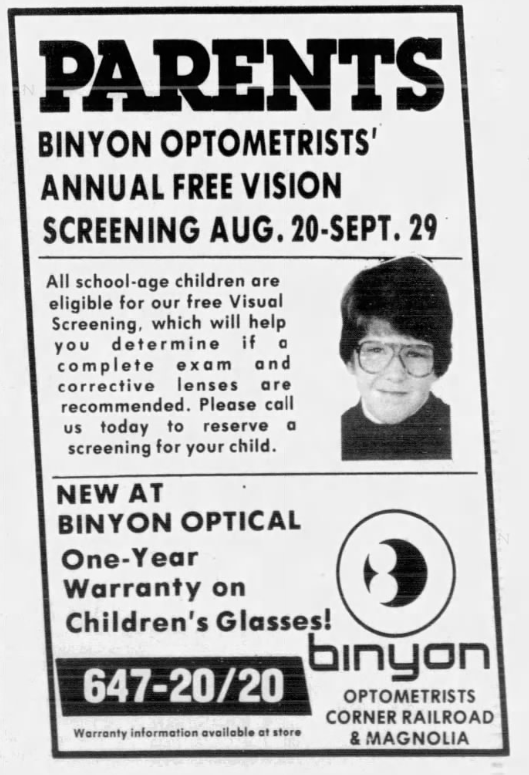
The other emphasis for Binyon Optometrists during this decade was the optical department. This was the first mention of “Binyon Optical” or “Binyon Optical Center.” Fashion, frames and sales made up the majority of the advertisements, definitely highlighting the large glasses style of the time.
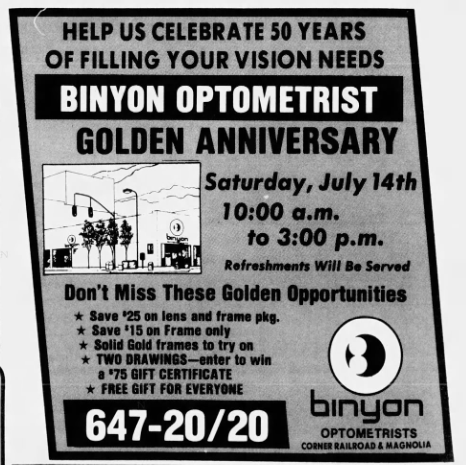
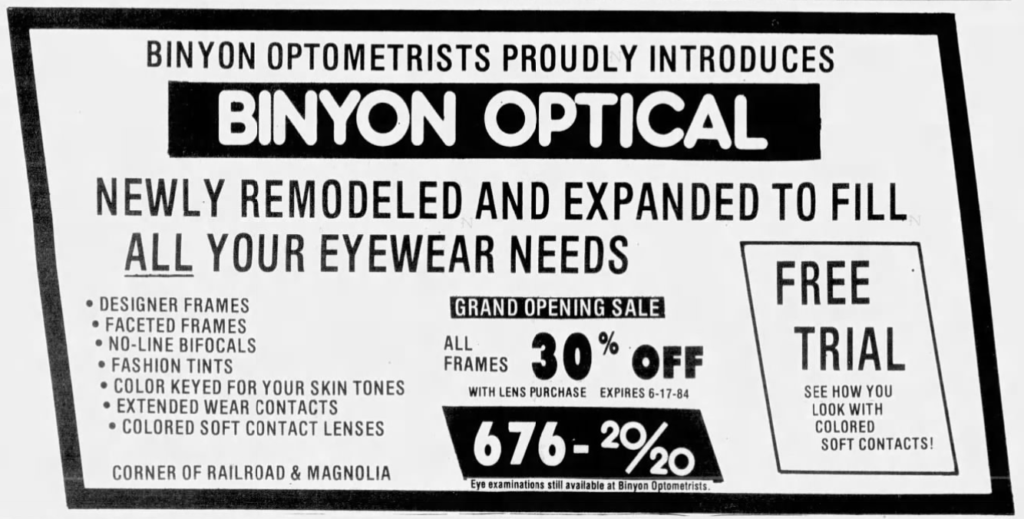
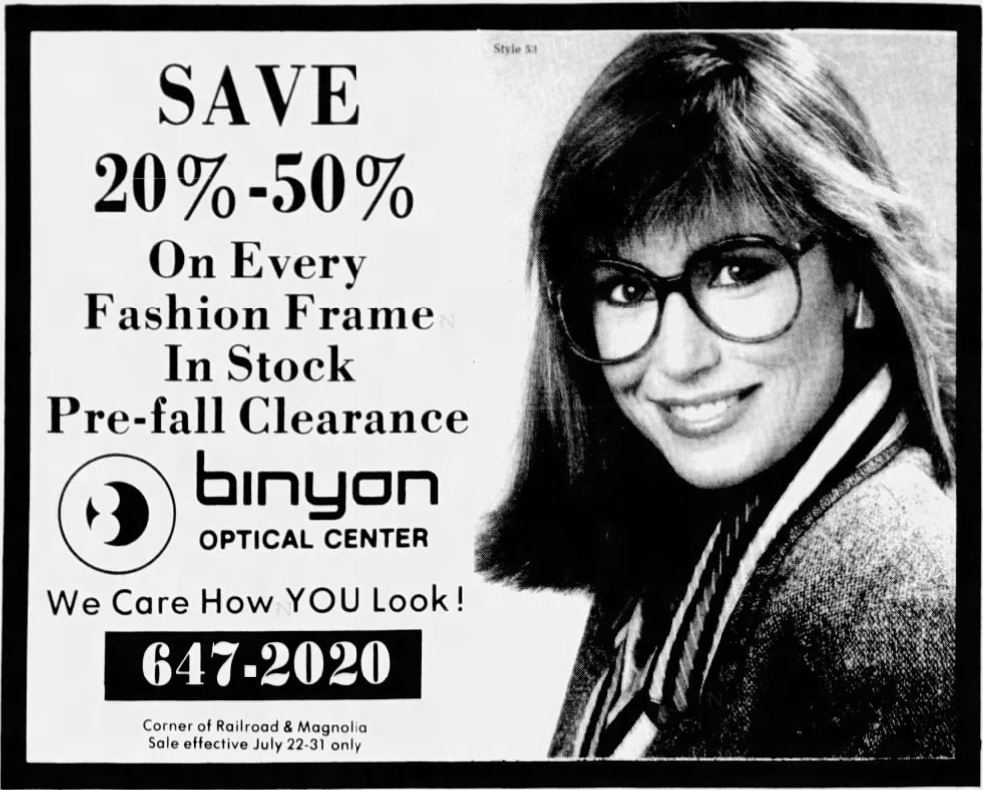
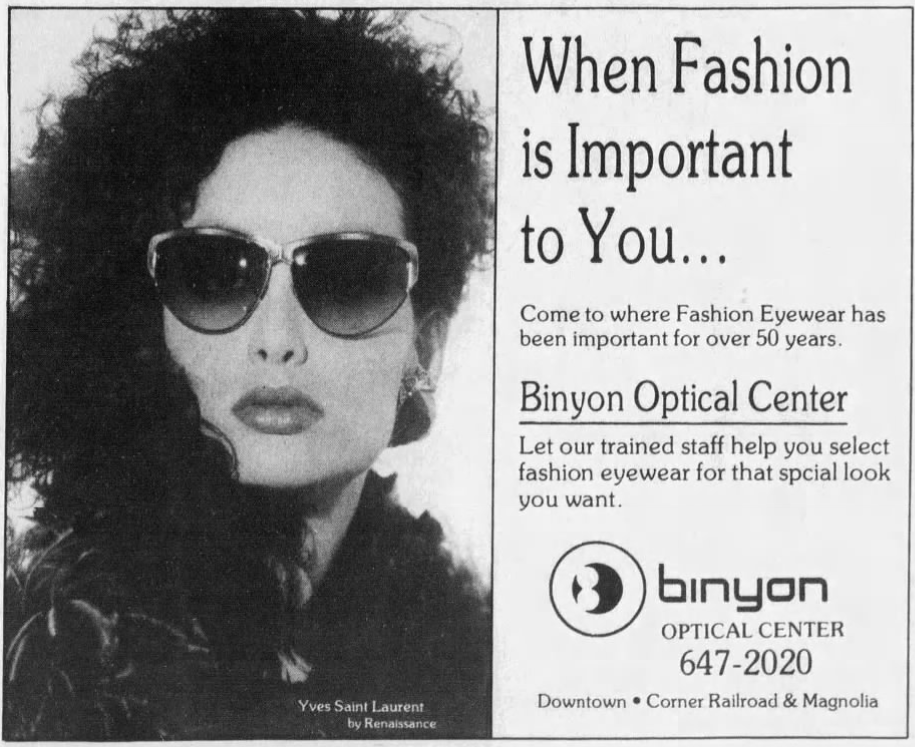
The Binyon team mourned the loss of partner Dr. Leroy Freeman in 1985, Dr. Binyon’s nephew, optometrist and part-owner of Binyon Optometrists in Bellingham since 1951.
It’s hard for many of us to think of including the 1990’s in a historical overview of Bellingham Herald advertisements, but again we get to see how the decade had a specific look. Binyon Optometrists, Binyon Optical rebrands as Binyon Vision Center. At this time, the Herald was the foremost source of local news and a feature in the Local section about the most recent move to the corner of Garden and E. Magnolia was a big deal. Even though the rebranded name is noted as “Binyon Vision Clinic” (not exactly), this is a great article to promote the new location.
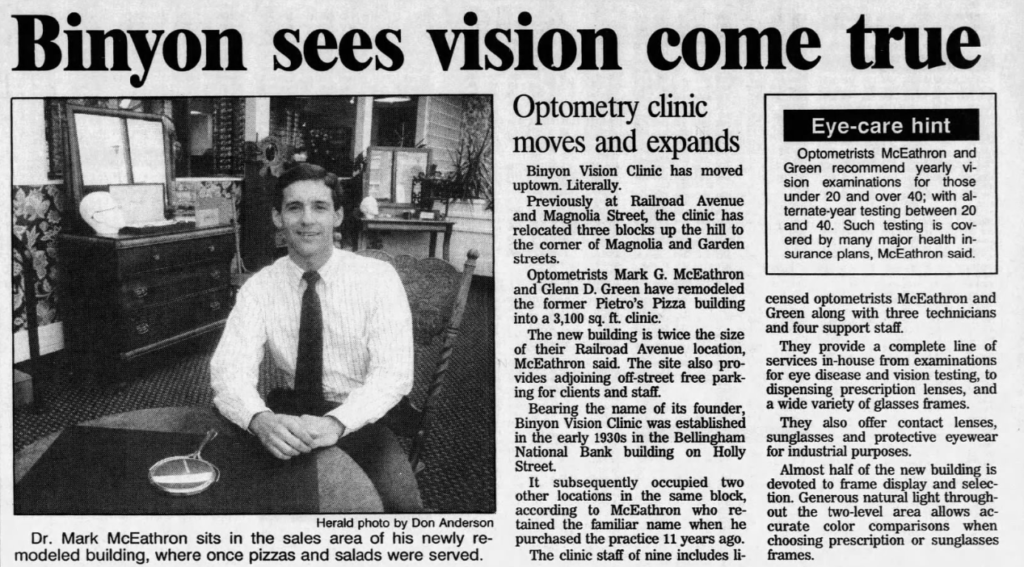
Advertised opportunities hoped to bring patients in to see the new office location with a few special events in this decade. Don’t miss the mention of Terry’s lattes – Bellingham has been espresso lovers for longer than most of the country!
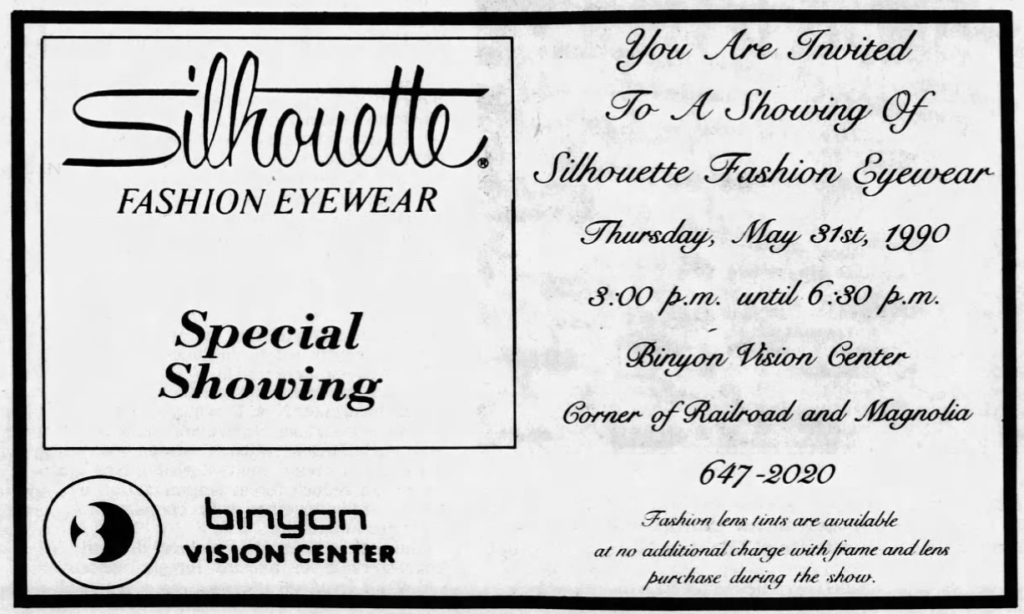
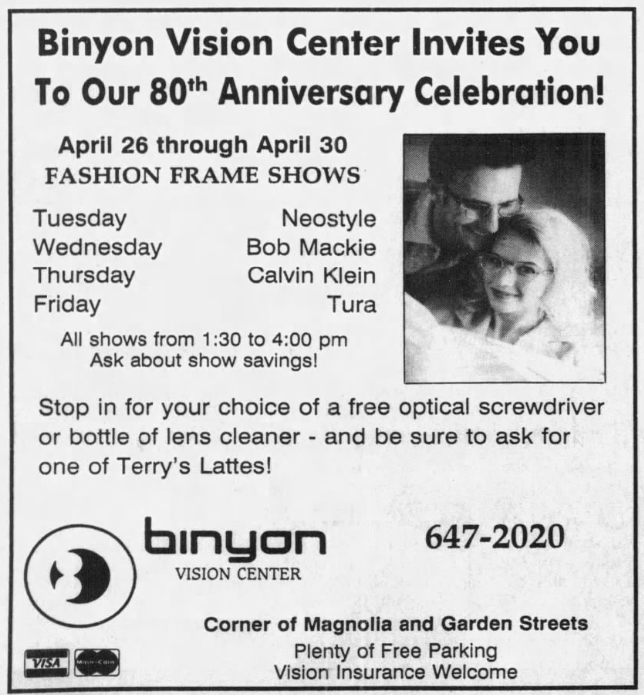
The 2000’s proved the last presence of Binyon Vision Center advertisements in the Bellingham Herald. Smaller vertical oriented ads highlighted the staff, new products and the services offered at Binyon:
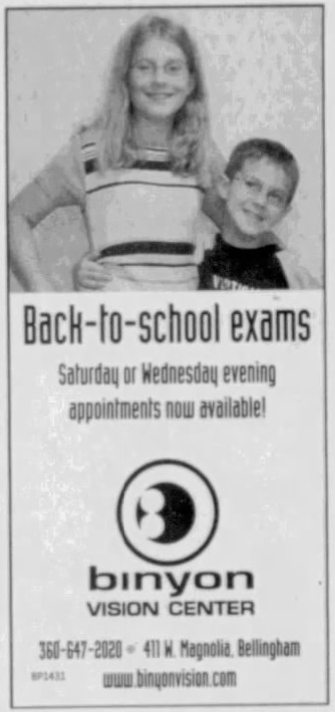
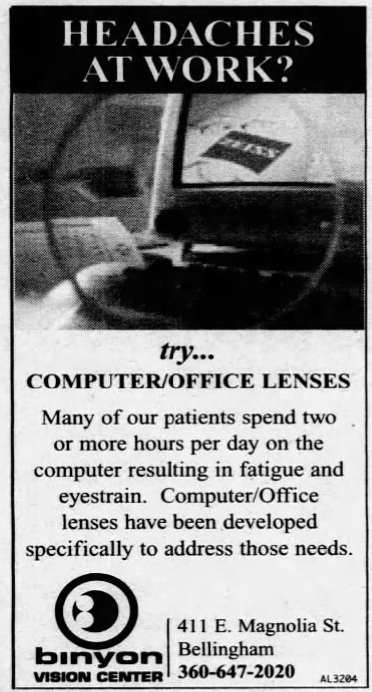
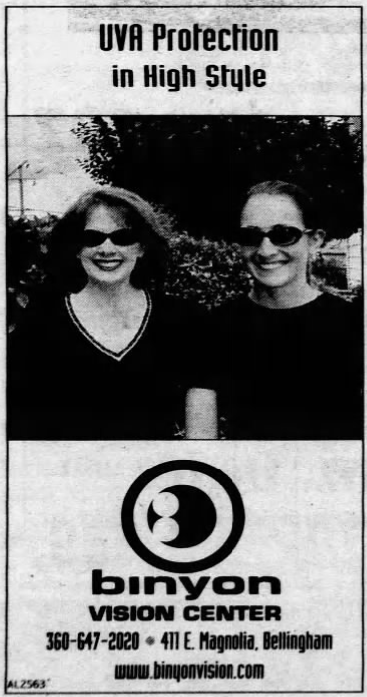
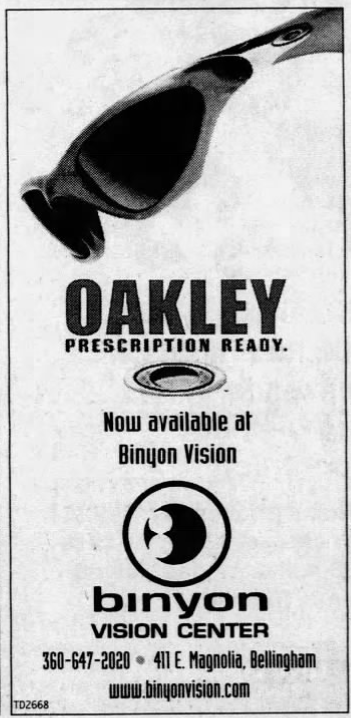
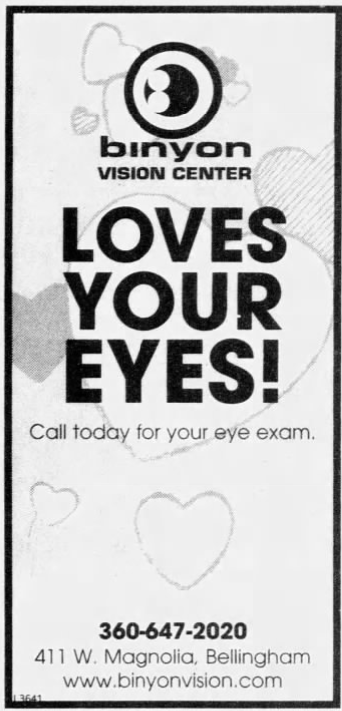
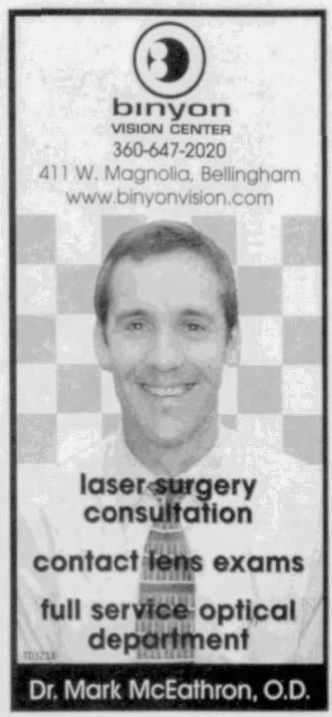
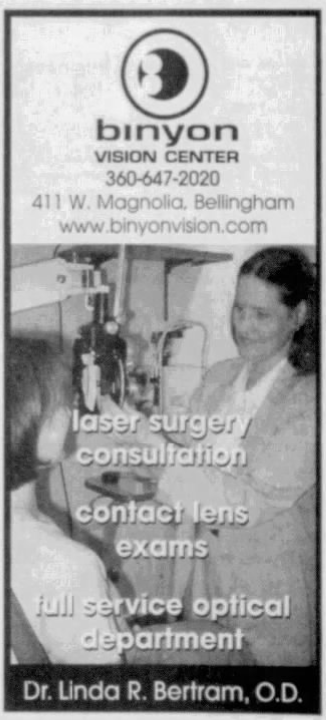
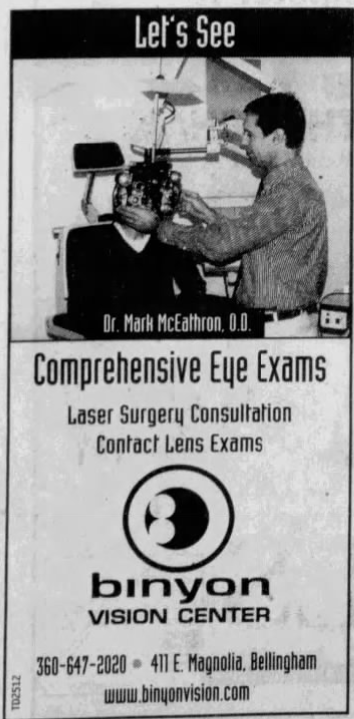
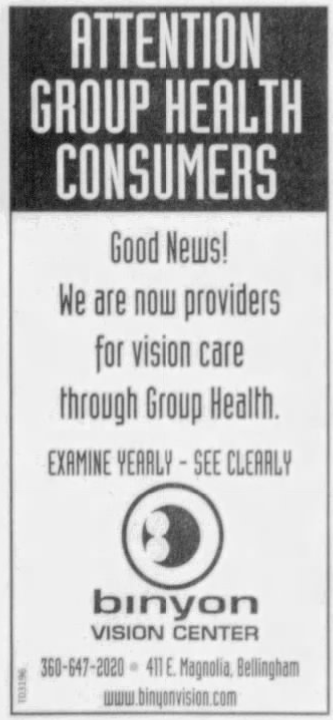
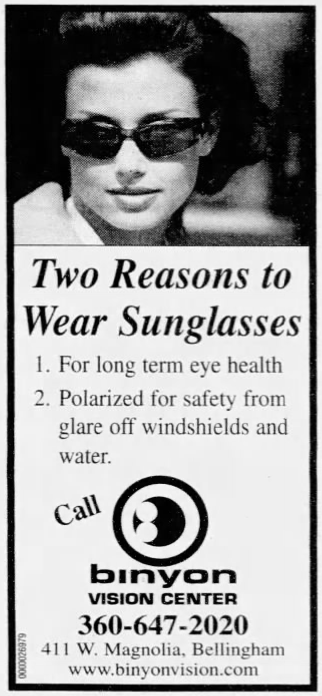
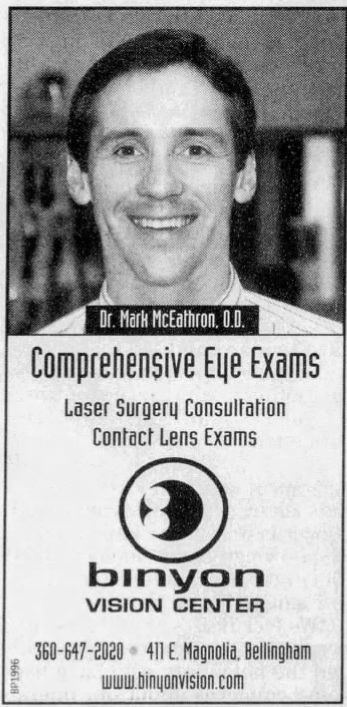

There is no doubt clip art was popular in this decade, we see this in these horizontally oriented advertisements for the optical department:
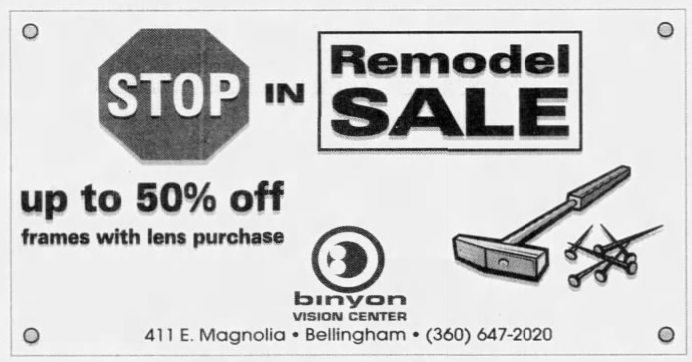
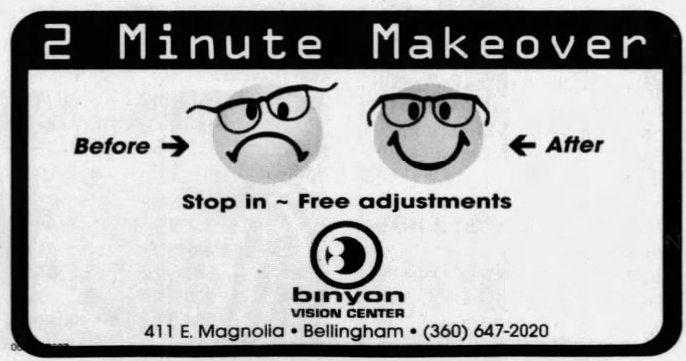
The opportunity to record Binyon Vision Center’s journey in Downtown Bellingham through these newspaper articles has been a privilege to share with you all! If you haven’t, please check out the first blog in this series with the advertisements from the 1930’s and 1940’s. We love our community, are thankful for the rich history we have here and are excited to continue the tradition of excellence in eyewear and eyecare for many many more years!
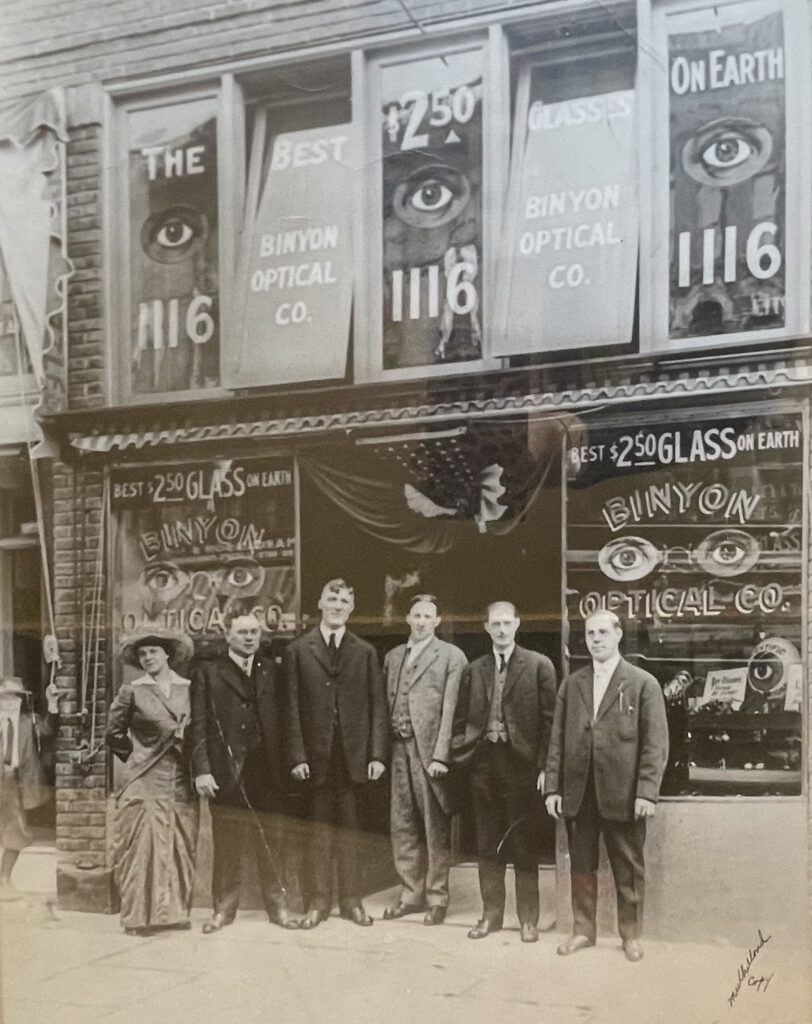
Dr. James R. Binyon opened the first Binyon Optical Company in 1911 on First Avenue in Seattle. He went on to open several other offices in Everett, Tacoma, Spokane, Richland, Yakima, Bremerton and Bellingham, which opened in 1934. At one time, it was estimated one of every three Washington families wore glasses dispensed by Binyon Optometrists. Binyon optometrists and opticians were trained to be masters of their craft- providing an excellence in glasses and service not found elsewhere. Today there are three remaining operating clinics with the Binyon name in Bellingham, Burien and Seattle, each operating independently.
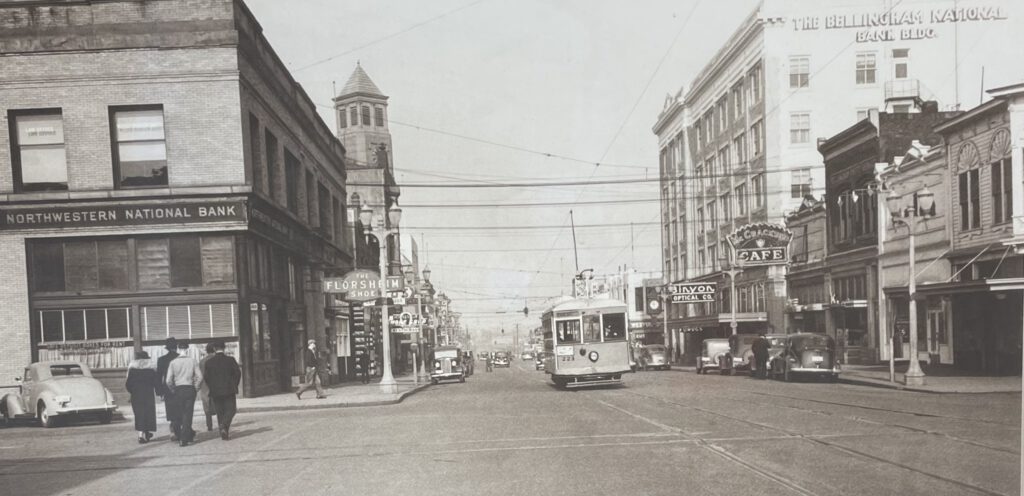
The Binyon office in Bellingham has always operated out of downtown- on Holly, Cornwall, Railroad Avenue and since 1993 on the corner of Garden and Magnolia Street. The Holly Street storefront opened in 1934 with Dr. J. H. Peterson practicing. The office moved to Cornwall Avenue in 1947. In 1951, Dr. Binyon’s nephew Dr. LeRoy Freeman moved to up to practice in the Bellingham office. Binyon made another downtown move to the corner of Railroad and Magnolia Street in 1974. Dr. Terrence Hansen joined Binyon Optometrists as an associate during that time. In 1980, Dr. Mark McEathron joined the practice. When Dr. Freeman passed away in 1985, Dr. McEathron, who was a partner at that time became the sole owner. In 1992, the office moved three blocks east on Magnolia into the former Pietro’s Pizza restaurant. This location offers over 1,000 square feet dedicated to frames displays and off-street parking. In 2019, Dr. Heather LeClaire joined Binyon Vision Center as an associate. After two years, she purchased the practice from Dr. McEathron, making her the first woman owner.
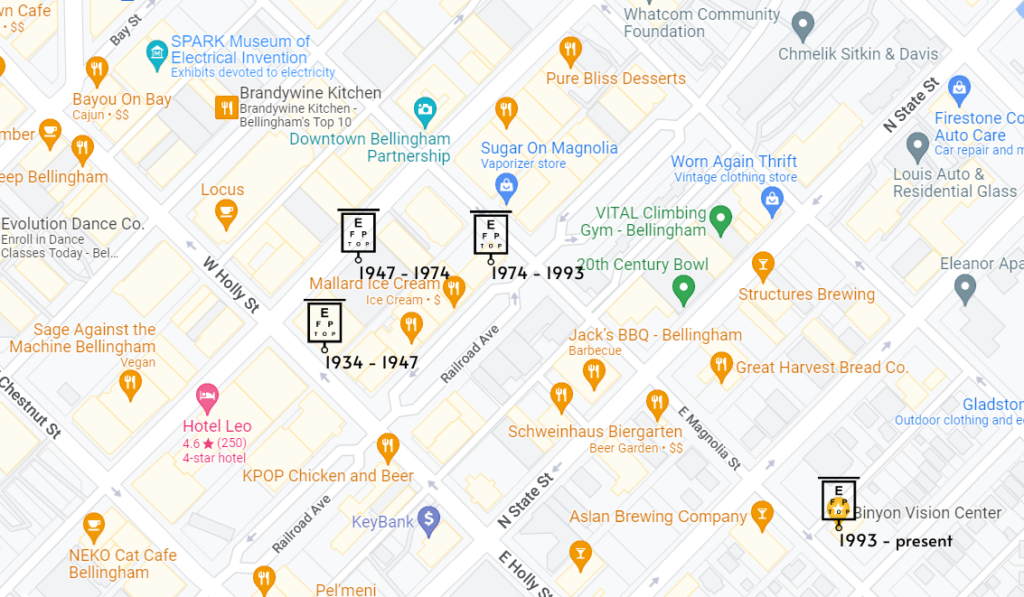
We have a unique opportunity to look at a business- in this case an optometrist office that provides eye exams and glasses- through the eyes of its newspaper advertisements. While today we have instant access to an internet search of “Bellingham optometrist,” even as recently as the 1990’s, newspaper marketing was vital for being seen by prospective and returning patients.
The Bellingham Herald was founded in 1890 as the Fairhaven Herald, and after a few mergers (just like our city), was renamed the Bellingham Herald in 1903. An amazing online resource – newspapers.com is the largest online newspaper archive – containing archives back to the 1770’s from over 23,900 newspapers including the Bellingham Herald. A search for “Binyon” in the Bellingham Herald brought up advertisements and press releases going back to the 1930’s. The creativity and current event references in these advertisements are a peek into marketing, US history, optometry, and downtown Bellingham. Here is a breakdown by decade of the historical advertisements for Binyon in the Bellingham Herald.
During the 1930’s, years of depression and economic hardship for the United States and Bellingham, Binyon advertisements focused on the importance of eye exams and subtly hinted at the stress on Bellingham resident’s finances. “We do not prescribe glasses unless absolutely necessary” appears in a few adverts.
An emphasis on the science of visual defects, having skilled, registered optometrists, and modernized equipment highlights eye health and vision as an important part of overall health and establishing credibility in the health profession.
An often repeated slogan is “Binyonize Your Eyes,” and by this point, Binyon Opticals had been operating for 20 years in other locations and had gained a healthy reputation for quality and service.
In the early 1940’s the themes of the past decade’s advertisements continued – “Your Eyes Deserve the Best” and “Truly Friendly Service” are notable phrases the company used to distinguish itself. The advertisements include higher quality artwork and reference the entire chain of Binyon plus wisely pointing out the doctor’s name and address for the Bellingham location.

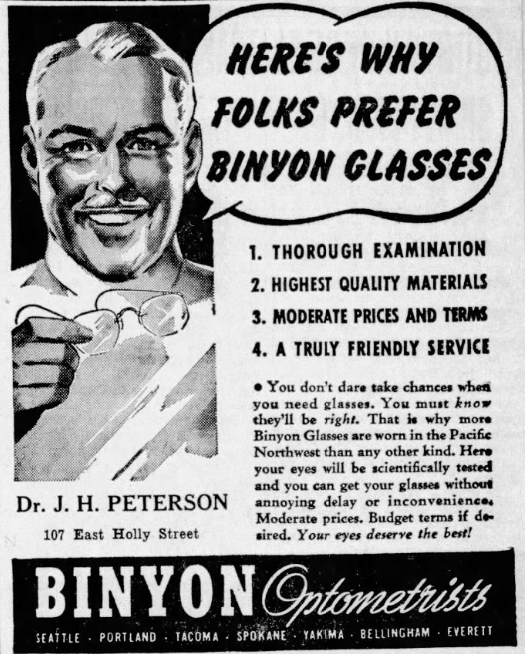

When the United States entered WWII, you see a definite shift in the messaging to relate the importance of having good vision to help the country’s wartime effort. It is fascinating to see the connection of one of the key times in US History to a local optometry’s advertisements. Visual efficiency is even called a patriotic duty and essential to help with wartime production. To note, the Bellingham Shipyard was the largest privately owned shipyard in the US in the 1940’s. They produced minesweepers during the war for the United States Navy.
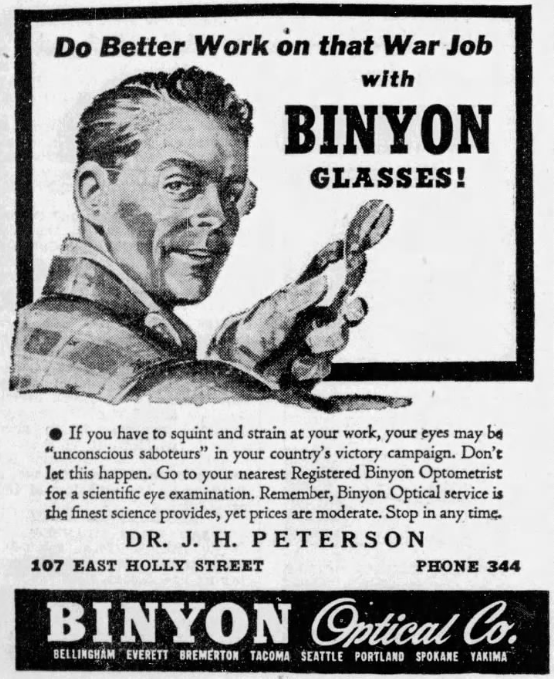
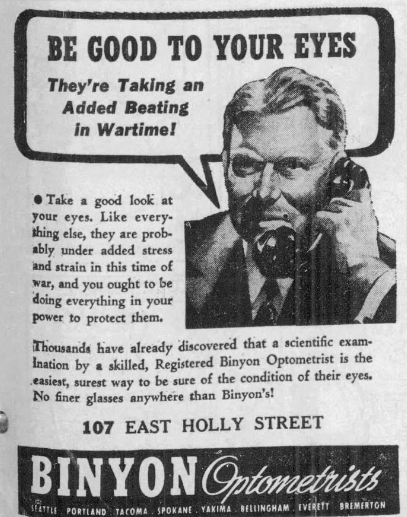
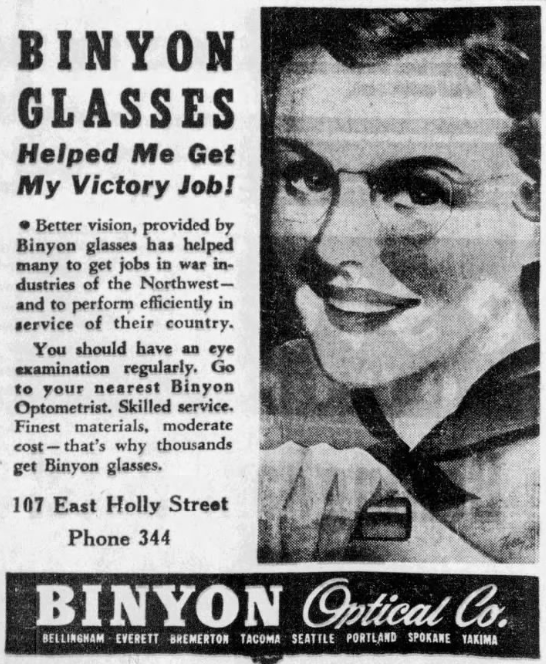
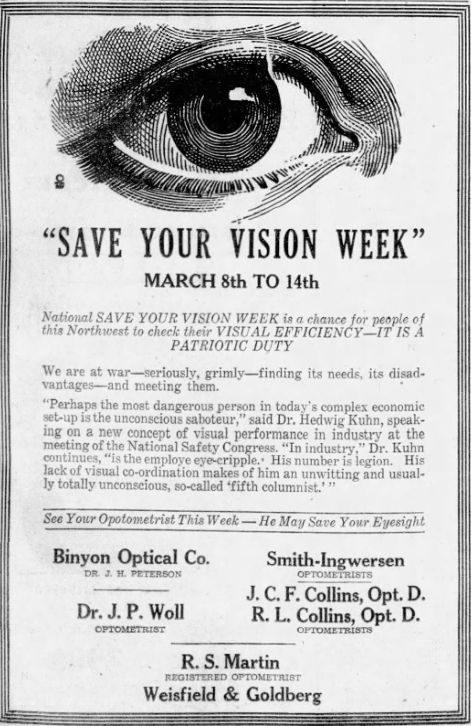
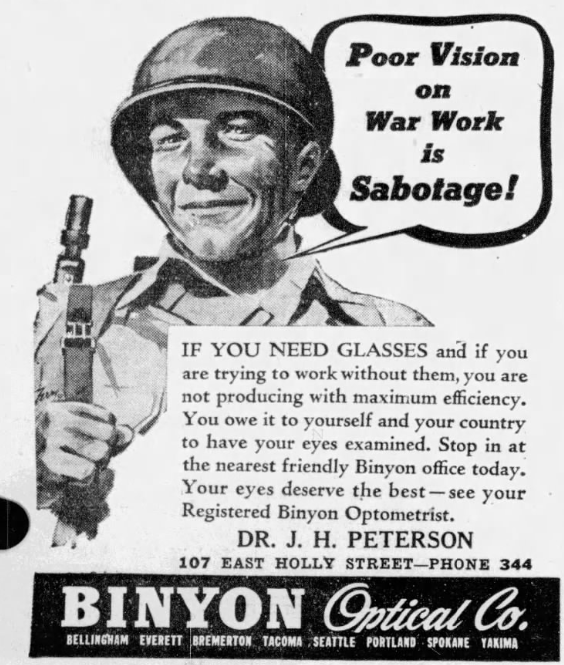
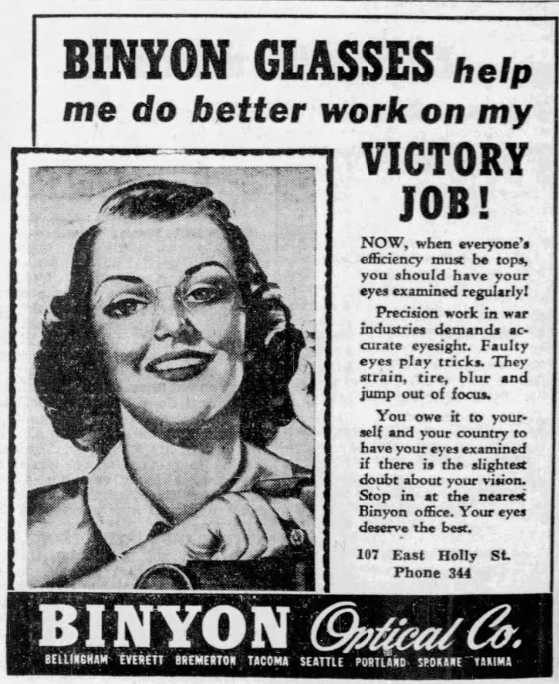
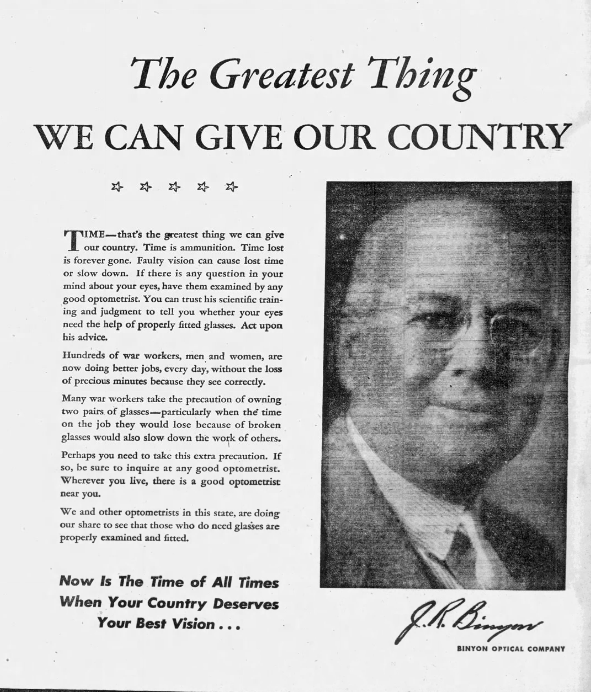
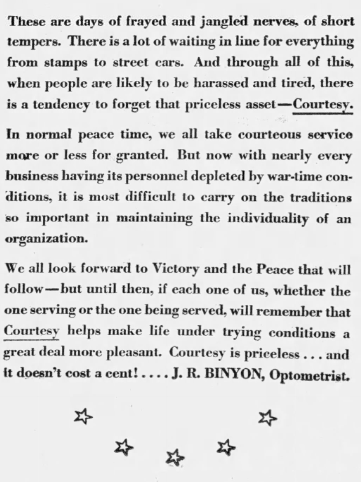
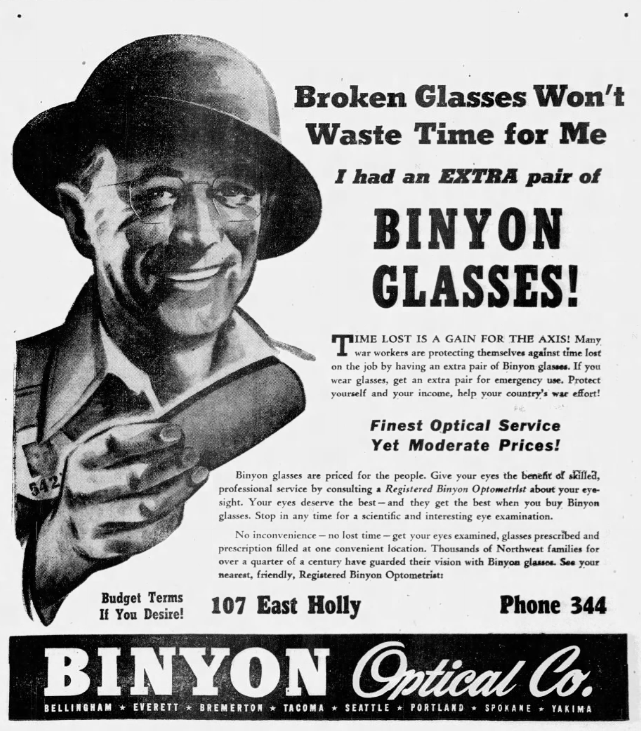
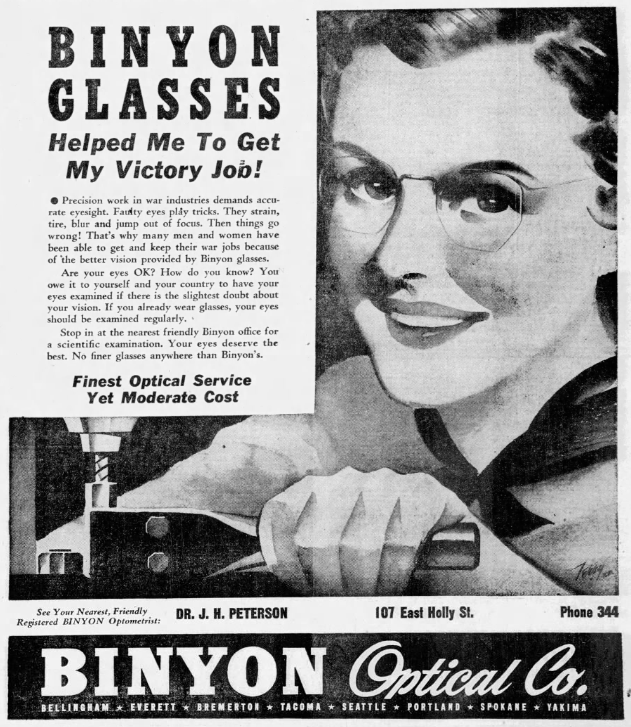
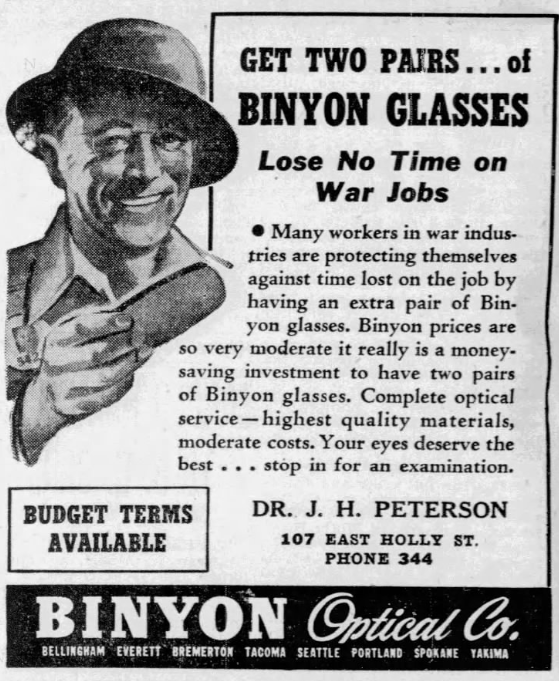
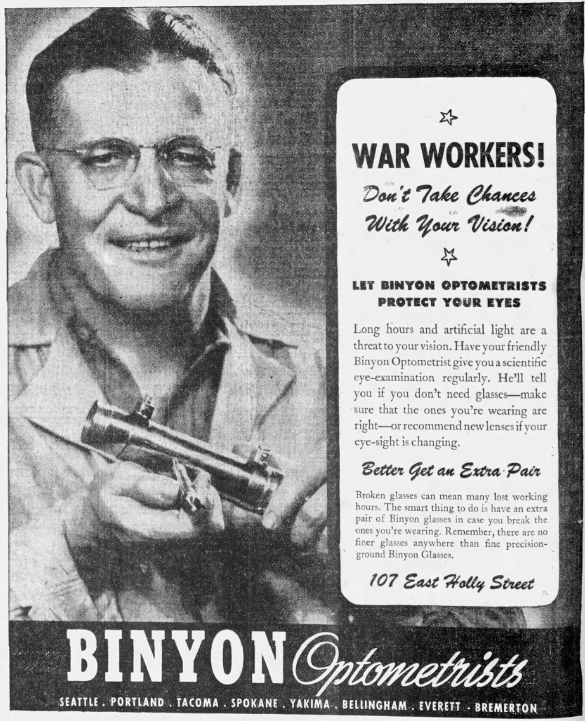
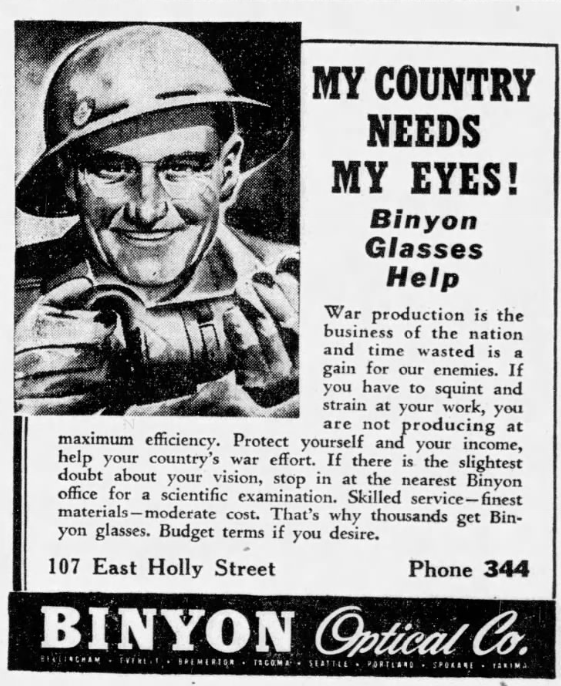
Other interesting additions in the 1940’s ads are the discussion of children’s vision and its effect on school work:
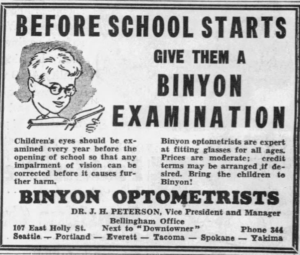
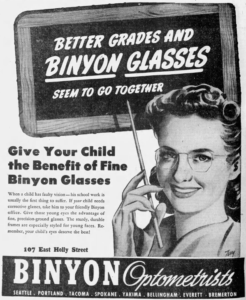
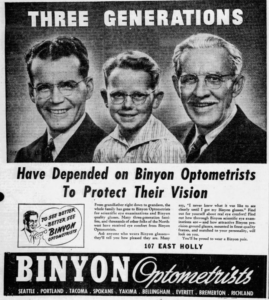
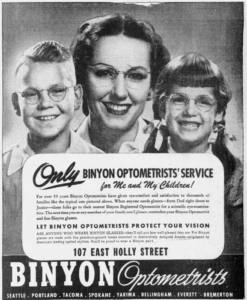
When the war ends, the advertisements go back to focusing on quality and service. One ad shows the proper steps to taking care of glasses. Binyon advertisements give solid advice for getting the most out of your glasses, the last step being to visit a quality optometrist for adjustments and new glasses when necessary.
The quality of glasses is a frequent theme in advertisements, including the importance of taking proper measurements and lens manufacturing. This is also an introduction to the “look” of glasses – the idea they can make you look younger and have style.
Like we see every November on social media – there is an advertisement posted to remember to vote.
There are also lifestyle advertisements in the later 1940’s – addressing specific tasks and their visual needs and how Binyon glasses can help address. “Enjoy Good Vision… Enjoy Sports More” is one tagline.
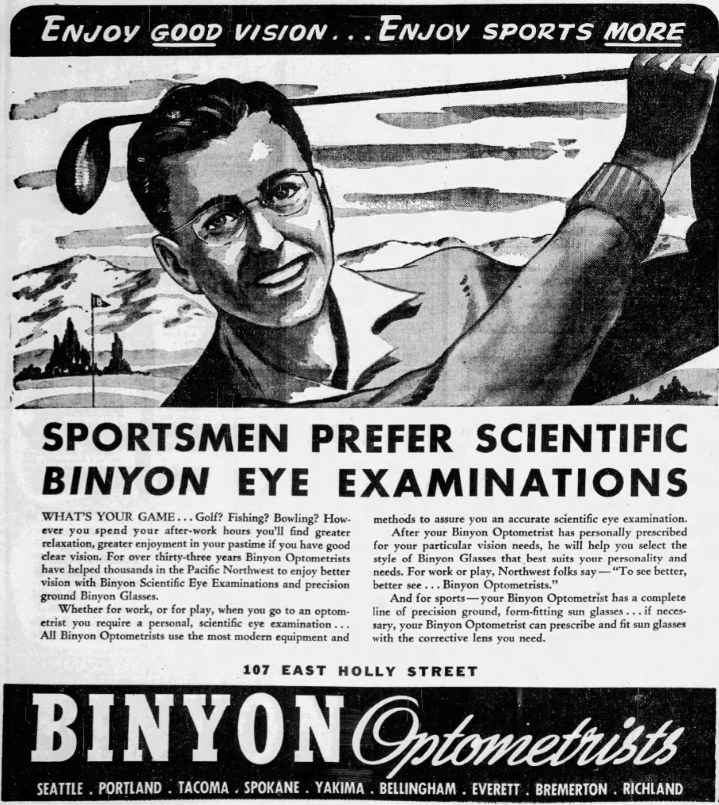
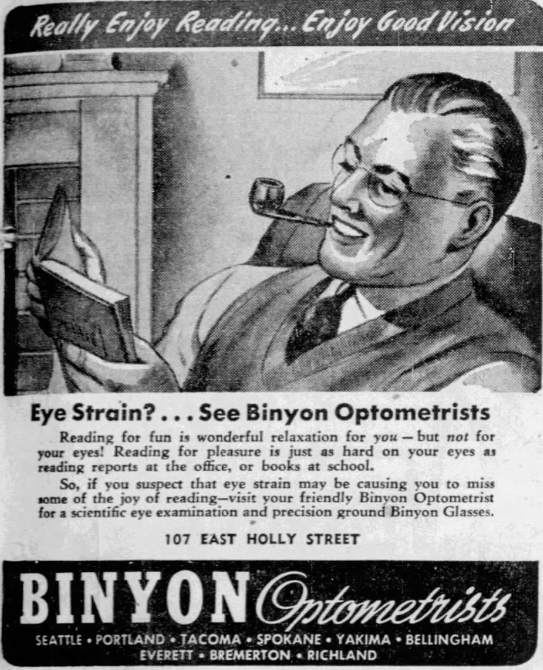

In 1947, the office moved to a new location, announced with a press release and a change in logo in some of the proceeding advertisements.

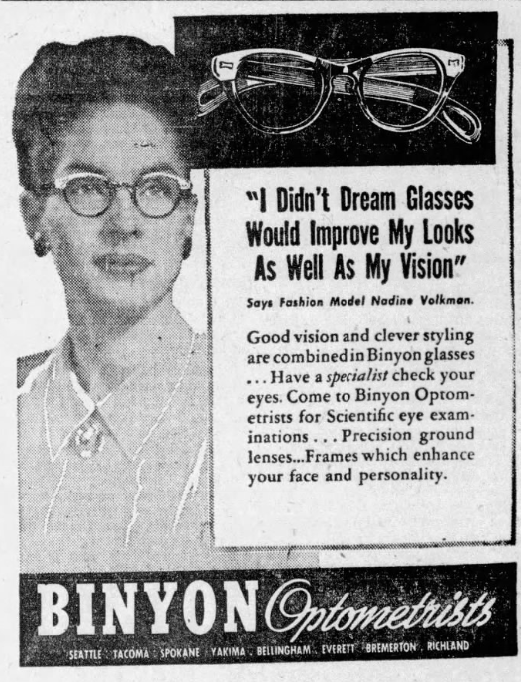



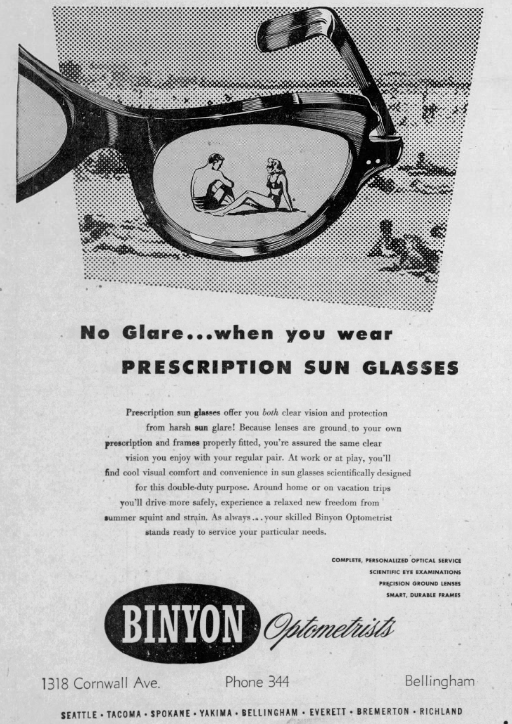

The advertisements from the Bellingham Herald by Binyon Optical Company in the 1930’s and 1940’s are an extensive walk through this important time period, in the most used medium of the day. There are five more decades to cover, with the newspaper advertisements becoming less each decade as other forms of marketing emerge. Stay tuned for the additional treasures to come in next month’s blog post!

We’re thrilled to partner with Bausch & Lomb to be an official One-by-One Recycling Center for contact lens plastic packaging and contact lens recycling. Drop off all opened blister pack waste- the top foil and the plastic and the contacts themselves to our office and we will mail them to the recycling facility.
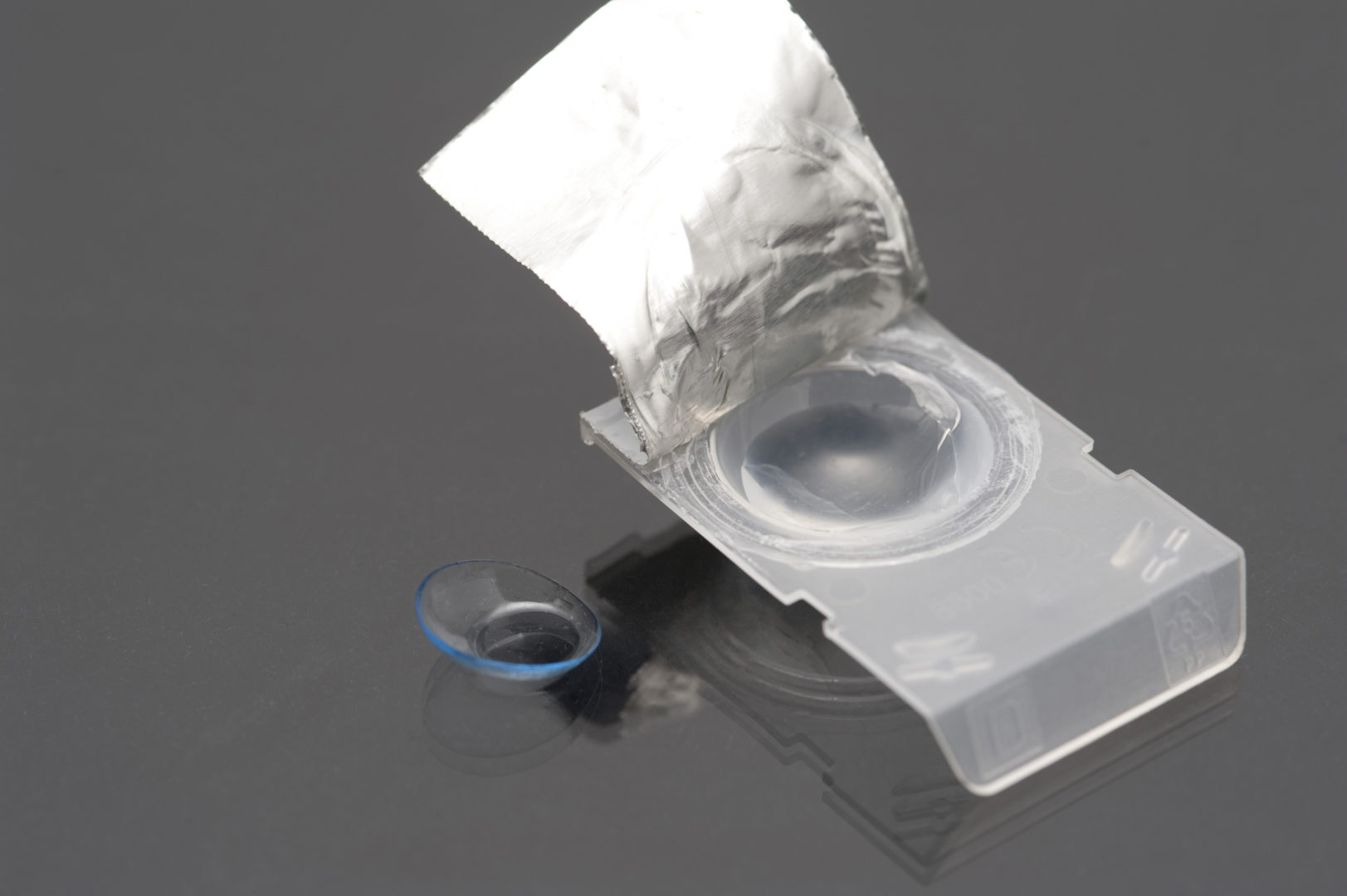
City recycling programs filter out contact lens packaging and send it to landfills due to their small size and packaging. Put together, the contact lens waste that the US generates annually could encircle the globe three times! We’re very thankful that Bausch & Lomb combined forces with TerraCycle(R) to tackle this problem and contribute to contact lens recycling. Below we outline the steps we recommend to collect and bring the waste to Binyon for proper disposal.
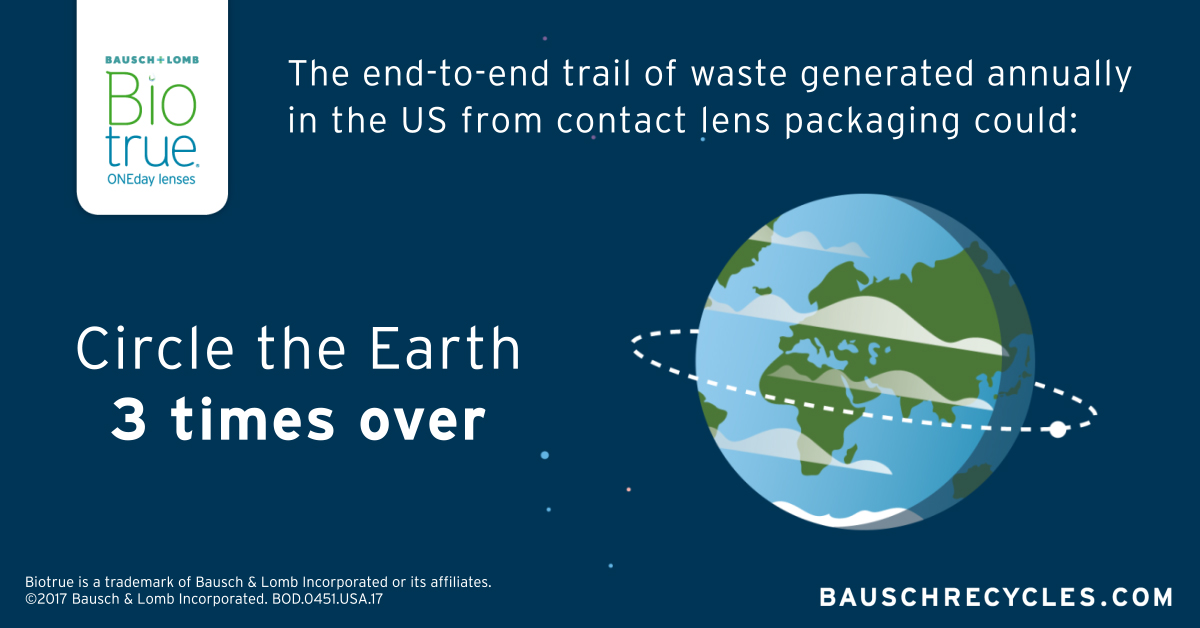
Waste will be shipped to TerraCycle, here it will be melted into plastic that can be remolded into recycled products. Recycled separately will also be foil tops.
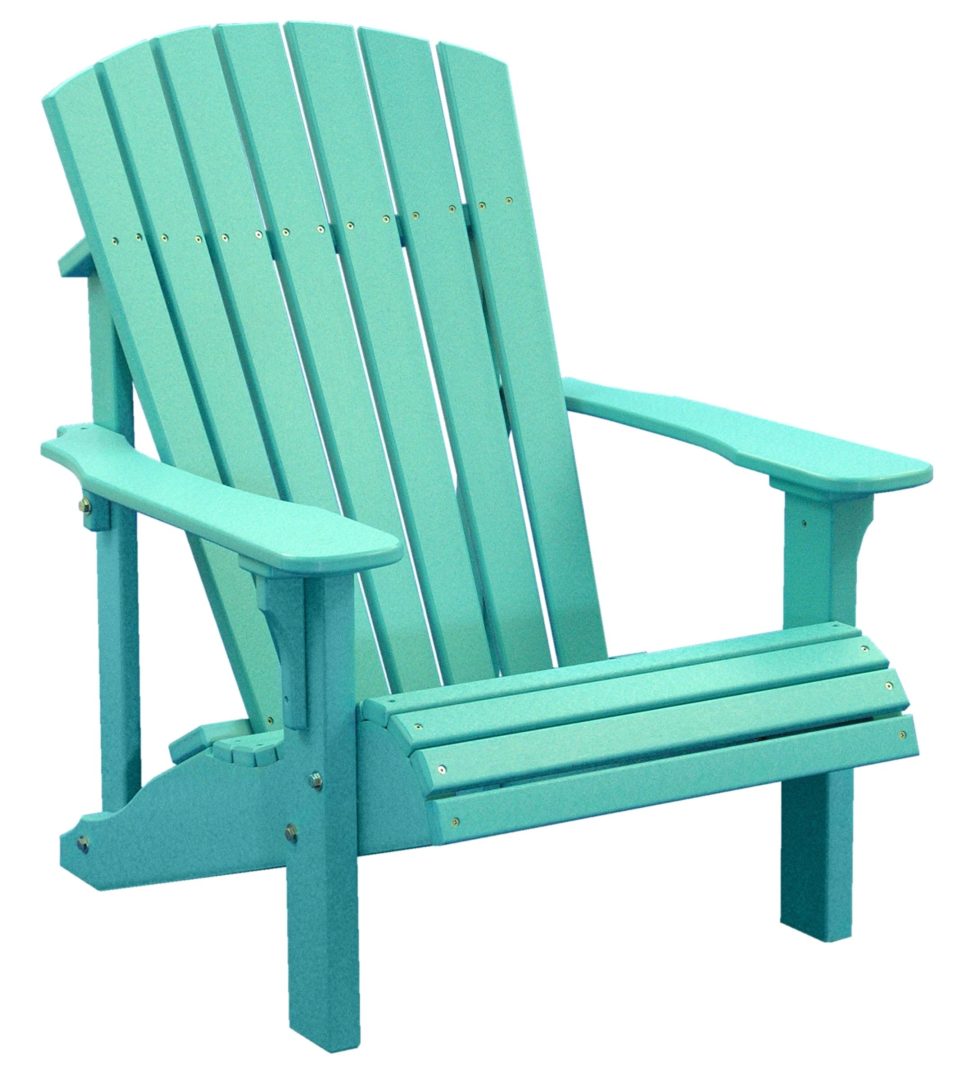
Another bonus? For every 2lbs of waste received, Bausch & Lomb will donate $1 to Optometry Giving Sight an awesome organization dedicated to provide eye exams and glasses to people in impoverished nations.

Questions! Feel free to contact us!
I hope that you’ve noticed the beautiful photo of Mt. Baker on the top of our website and of Whatcom Falls in the slide show on our website. There’s no question that we live in one of the most beautiful, picturesque areas of the world. Peter Klco of Peter James Photography has an amazing eye for capturing an overall breathtaking photo of our landscape with an attention to the small details that will leave you mesmerized.
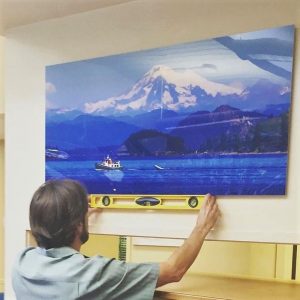
Peter also does web design and we had the great pleasure of working with him on our website last summer. He makes the design and site construction process very personalized, well organized. And, brings a wealth of knowledge on the ever changing landscape (intended pun) of marketing yourself successfully on the internet.
We found many similarities between our worlds of photography and optometry. Both are centered on the visual system and how to create the best possible images for our consumer. Peter has a variety of cameras, lenses and equipment to create his images – while Dr. McEathron will sometimes prescribe a variety of glasses prescriptions to help create the clearest image at different distances (distance, reading, computer).
There are many choices of medium to print Peter’s images on. Lately he’s chosen metal as a substrate of choice because of how vivid and bright the images appear. We have many choices in lens materials and designs to offer our patients in glasses. We first recommend digital freeform lenses. These provide vision most accurate to the prescription and customized for how the patient wears it in their particular frame.
It was a joy to work with Peter and his team and we’d like to invite all of you to become familiar with his fantastic photography work and to seek him out for assistance with a website if the need arrives! In addition to providing high quality work, the team is committed to giving back by planting 100 trees for every photo purchased and website created through the Trees for the Future campaign.